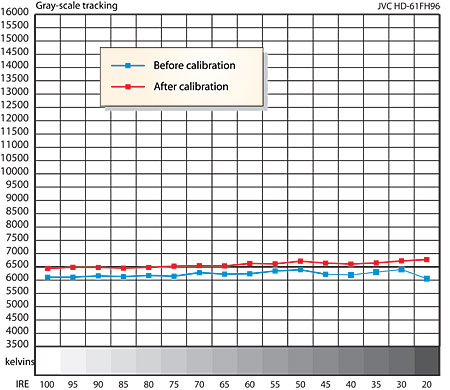JVC HD-61FH96 1080p HDTV Tests and Calibration
The geometry of the JVC's image was virtually perfect, with no measurable vertical or horizontal size differential in both the Full (anamorphic) or Normal (4:3) aspect ratio settings. There was slight pixel misconversion (fairly common in 3-chip displays), generally no more than half a pixel. It was not visible from a normal viewing distance.

With a 480p or 480i HDMI input, the JVC's overscan averaged less than 3% on all sides (4% maximum, 0.5% minimum). In both 720p and 1080i, HDMI, it ranged from a minimum of 1% to a maximum of 3%, with an average of 2%.
With a 480p or 480i component input, overscan averaged less than 3% (1% minimum, 3.5% maximum). In both 720p and 1080i component, it was 3% on the top and 2% on all other sides (average 2.25%).
The JVC's deinterlacing and scaling was good (though not outstanding) with scores ranging from fair to excellent on my cocktail of torture tests. It did perform noticeably better on some of these tests with Natural Cinema (3/2 pulldown) set to On or Off, as appropriate, rather than to Auto, suggesting that the Auto-detect circuit for the presence of film-based material could sometimes be fooled (as it can on most such Auto devices). In any event, deinterlacing and scaling artifacts were never obvious during my time watching real program material on the set. The difficult vibrating strings on the computer animated Animusic were flawless.
The noise reduction controls were occasionally helpful, and relatively subtle, even in the maximum setting. While NR did reduce the image sharpness, the loss of detail was small and sometimes resulted in an overall improvement in the image for viewers sensitive to very low levels of video noise in the program material. Even without NR, the set has subjectively negligible levels of video noise.
At 480i and 480p, with either a component or HDMI input, both the JVC's luminance (black and white) and chroma (color) responses held up to the maximum multiburst frequencies of my Accupel HDG-3000 test pattern generator (6.75MHz at 480i, 13.5MHz at 480p).
At both 720p and 1080i in component and HDMI, the luminance was resolved up to the maximum of 37.1MHz, though this frequency was clearly a bit weaker in component. The HDMI color response was also better maintained to the top of the range with HDMI than with component. Though with both input types at both HD resolutions the colors at 37.1MHz were strongly visible, they were not as cleanly differentiated as at lower frequencies. None of these color results translated into visible problems or limitations on any normal program material.
The JVC's red color primary was respectably close to the standard. Its green color point, however, was significantly deeper into green than the standard calls for. And blue was also deeper into blue than the standard, though the error here was less visible (the eye is far more sensitive to green than to blue).
The JVC's green color point clearly affects its image. But in this respect it's not much different than many competitive digital sets, which by and large appear hung up on "fresh" green—a green with an intense, Crayola quality (particularly in bright, sunlit scenes) that I've never seen on film. But the JVC's overall color was satisfying and often superb, depending on the program material. The overdone greens were a distraction only on shows with lots of bright foliage (think Lost).
The set displayed below black with a component source, but below black was barely visible (at any setting of the brightness control) in HDMI.
The JVC's pre-calibration gray scale (in Theater Pro mode) was respectably close to 6500K, but its readings were a bit on the low side and a bit plus green through all of the brightness range. After calibration the result was noticeably better, not only in ways visible in the curve, but with the measured results much closer to D6500 (±0.004 from 30IRE to 100IRE, and 0.005 at 20IRE).
The peak contrast measured (50.9 foot-Lamberts peak white, 0.034fL video black) at a Picture setting of -11, Brightness at -5, in Theater mode.
- Log in or register to post comments


























































